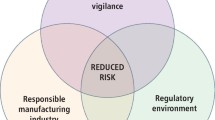Key Points
-
Suggests that dental practice should be the prime location for clinical dental research.
-
Discusses patients concerns regarding which dental materials are used.
-
Demonstrates that patients care strongly that the materials are of a high quality and have been thoroughly researched.
Abstract
Aims It is the aim of this study to determine, by means of a questionnaire completed by patients attending ten UK dental practices, patients' level of knowledge on dental materials and techniques.
Materials and methods Members of The PREP (Product Research and Evaluation by Practitioners) Panel were asked to recruit patients to participate in a questionnaire-based assessment of their knowledge of dental materials.
Results Two hundred and forty-nine patients took part in the questionnaire. Sixty-three percent (n = 157) of the respondents were female and 92% (n = 229) of the respondents stated they were regular attenders at the dental practice. The respondents were asked how important the quality of dental materials used in their mouth was, and on a Visual Analogue Scale (VAS) where 1 = not important and 10 = very important, the result was 9.6. The same score was recorded when they were asked how important it was that the materials used in their mouth were supported with relevant clinical research evidence and long term data of the success of the material. They were also questioned on the subjects of price, manufacturer, source or material and type of filling material. A significant amount of respondents demonstrated that they had concerns over the use of amalgam.
Conclusions Respondents expressed strong views that the materials used on their teeth should have a robust evidence base and they care about the materials that are used in their mouths.
Similar content being viewed by others
Log in or create a free account to read this content
Gain free access to this article, as well as selected content from this journal and more on nature.com
or
References
Burke F J T, McCord J F . Research in dental practice – problems and solutions. Br Dent J 1993; 175: 396–398.
Burke F J T, Crisp R J . Twenty years of handling evaluations and practice-based research by the PREP Panel. Dent Update 2013; 40: 339–341.
Dillman D A . Effects of questionnaire length, respondent-friendly design and a difficult question on response rates for occupant-addressed census mail surveys. Pub Opin Quart 1993; 57: 289–304.
Burke F J T . Amalgam to tooth-coloured materials – implications for clinical practice and dental education: governmental restrictions and amalgam-usage survey results. J Dent 2004; 32: 343–350.
Burgersdijk R, Truin G-T, Kalsbeek H, van'Hof M, Mulder J . Objective & subjective need for cosmetic dentistry in the Dutch population. Comm Dent.Oral Epidemiol 1991; 19: 61–63.
Burke F J T . Me too. Dent Update 2010; 37: 137.
Burke F J T . Me too 2. Dent Update 2011; 38: 586–592.
Christensen G J . Are you using “grey market” or counterfeit dental products? J Am Dent Assoc 2010; 141: 712–713.
Mickenautsch S . How well are current GIC product labels related to current systematic review evidence? Dent Update 2011; 38: 634–644.
Burke F J T . The evidence base for “own label” resin-based dental restoratives. Dent Update 2013; 40: 5–6.
Wahl M J . Amalgam – resurrection and redemption. Part 1: The clinical and legal mythology of anti-amalgam. Quintessence Int 2001; 32: 525–535.
Wahl M J . Amalgam – resurection and redemption. Part 2: The medical mythology of anti-amalgam. Quintessence Int 2001; 32: 696–710.
Author information
Authors and Affiliations
Corresponding author
Additional information
Refereed Paper
Rights and permissions
About this article
Cite this article
Burke, F., Crisp, R. A practice-based assessment of patients' knowledge of dental materials. Br Dent J 219, 577–582 (2015). https://doi.org/10.1038/sj.bdj.2015.956
Accepted:
Published:
Issue date:
DOI: https://doi.org/10.1038/sj.bdj.2015.956


